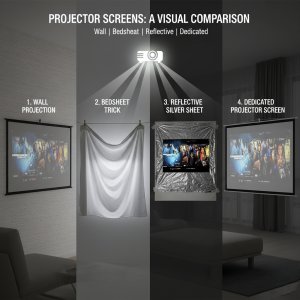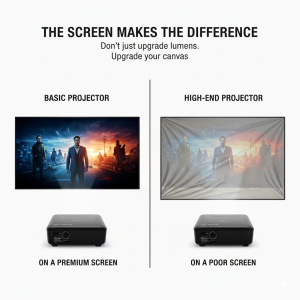Hello Ultimea Fam,
When we talk about projectors, we often get caught up with brightness, resolution, and sound - but one thing that quietly decides how “cinematic” your movie feels is the screen surface itself!
Whether it’s a plain wall, a simple bedsheet, or a professional ALR screen - each gives a totally different experience. Let’s talk about the types of screens people use and what really makes the difference

Most beginners start here - projecting directly on a wall. It’s the easiest, most accessible way to start your home theatre journey.
If your wall is smooth and light-colored, you can get surprisingly decent results. But once you look closely, you’ll see the limitations.
Pros:
• Free and simple
• Great for testing projectors
• Looks neat if wall is clean and matte
Cons:
• Texture or gloss can blur images
• Colors and brightness look dull
• Ambient light kills the contrast
 Pro tip: Use matte white paint if you plan to stick with wall projection - it helps reflect light more evenly.
Pro tip: Use matte white paint if you plan to stick with wall projection - it helps reflect light more evenly.
Raise your hand if you’ve tried this one
I personally started with a plain white bedsheet. It felt fun, affordable, and honestly, gave decent results for casual viewing.
Of course, wrinkles and folds make a difference — but that first “movie night” feeling always stays special.
Pros:
• Super affordable
• Easy to hang and remove
• Works great for outdoor movie setups
Cons:
• Wrinkles distort the image
• Needs a dark background
• Brightness and sharpness drop a bit
 Tip: Stretch it tightly and add a cardboard or thick backing for better light reflection.
Tip: Stretch it tightly and add a cardboard or thick backing for better light reflection.
After a while, I tried a silver reflective sheet setup with my basic BlitzWolf projector, and honestly, it surprised me.
The colors popped more, and contrast improved - it felt like a step up from a wall or bedsheet.
This setup is perfect for those who want to experiment before investing in a real screen.
Pros:
• Better contrast and brightness
• Budget-friendly improvement
• Works fine even in low-light rooms
Cons:
• Needs smooth surface and proper tension
• Not as uniform as professional screens
This is where the magic happens.
A good projector screen is designed to reflect light uniformly, preserve contrast, and deliver accurate colors - something no wall or cloth can fully achieve.
Popular Types:
Matte White Screen: Balanced color & brightness for dark rooms.
Gray (High Contrast) Screen: Improves black levels; great in mild light.
ALR (Ambient Light Rejecting) Screen: Blocks room light, boosts brightness - ideal for bright environments.
Pros:
• Best image quality
• Consistent contrast and sharpness
• True “home theatre” vibe
Cons:
• Expensive
• Requires setup space
It depends on your setup and budget:
Testing phase → Go with a wall or bedsheet.
Regular use → Matte white or silver sheet works well.
Cinematic setup → Nothing beats a dedicated ALR screen.
No matter how advanced your projector is, the screen decides how the final image truly looks.
Even a basic BlitzWolf projector can feel like a mini theatre if paired with the right surface.
So next time you think about upgrading your setup - don’t just think about lumens or resolution; think about the canvas that completes the picture.

After all, the screen is where your movies come alive!

Harsh Jain

When we talk about projectors, we often get caught up with brightness, resolution, and sound - but one thing that quietly decides how “cinematic” your movie feels is the screen surface itself!
Whether it’s a plain wall, a simple bedsheet, or a professional ALR screen - each gives a totally different experience. Let’s talk about the types of screens people use and what really makes the difference

1. The Plain Wall Setup
Most beginners start here - projecting directly on a wall. It’s the easiest, most accessible way to start your home theatre journey.
If your wall is smooth and light-colored, you can get surprisingly decent results. But once you look closely, you’ll see the limitations.
Pros:
• Free and simple
• Great for testing projectors
• Looks neat if wall is clean and matte
Cons:
• Texture or gloss can blur images
• Colors and brightness look dull
• Ambient light kills the contrast
2. The Bedsheet Screen - Our First DIY Upgrade
Raise your hand if you’ve tried this one
I personally started with a plain white bedsheet. It felt fun, affordable, and honestly, gave decent results for casual viewing.
Of course, wrinkles and folds make a difference — but that first “movie night” feeling always stays special.
Pros:
• Super affordable
• Easy to hang and remove
• Works great for outdoor movie setups
Cons:
• Wrinkles distort the image
• Needs a dark background
• Brightness and sharpness drop a bit
3. Reflective or Silver Sheet Setup - The Budget Pro Move
After a while, I tried a silver reflective sheet setup with my basic BlitzWolf projector, and honestly, it surprised me.
The colors popped more, and contrast improved - it felt like a step up from a wall or bedsheet.
This setup is perfect for those who want to experiment before investing in a real screen.
Pros:
• Better contrast and brightness
• Budget-friendly improvement
• Works fine even in low-light rooms
Cons:
• Needs smooth surface and proper tension
• Not as uniform as professional screens
4. Dedicated Projector Screens - The Real Cinematic Experience
This is where the magic happens.
A good projector screen is designed to reflect light uniformly, preserve contrast, and deliver accurate colors - something no wall or cloth can fully achieve.
Popular Types:
Matte White Screen: Balanced color & brightness for dark rooms.
Gray (High Contrast) Screen: Improves black levels; great in mild light.
ALR (Ambient Light Rejecting) Screen: Blocks room light, boosts brightness - ideal for bright environments.
Pros:
• Best image quality
• Consistent contrast and sharpness
• True “home theatre” vibe
Cons:
• Expensive
• Requires setup space
So, What’s the Best Option?
It depends on your setup and budget:
Testing phase → Go with a wall or bedsheet.
Regular use → Matte white or silver sheet works well.
Cinematic setup → Nothing beats a dedicated ALR screen.
Final Thoughts
No matter how advanced your projector is, the screen decides how the final image truly looks.
Even a basic BlitzWolf projector can feel like a mini theatre if paired with the right surface.
So next time you think about upgrading your setup - don’t just think about lumens or resolution; think about the canvas that completes the picture.

After all, the screen is where your movies come alive!
And yes… someday soon, I definitely want to experience it on a proper ALR screen with a laser projector setup — that’s my dream combo, and obviously a great home theatre also
Harsh Jain
Last edited:
